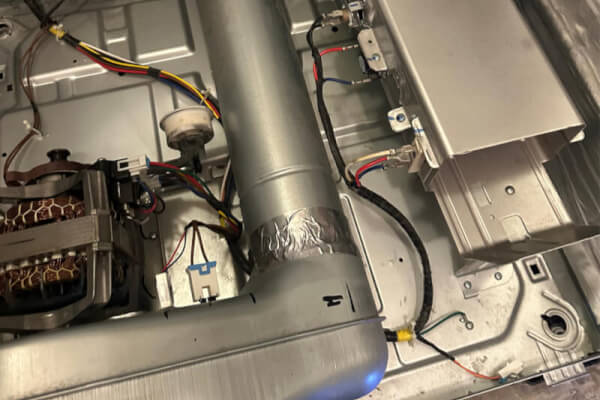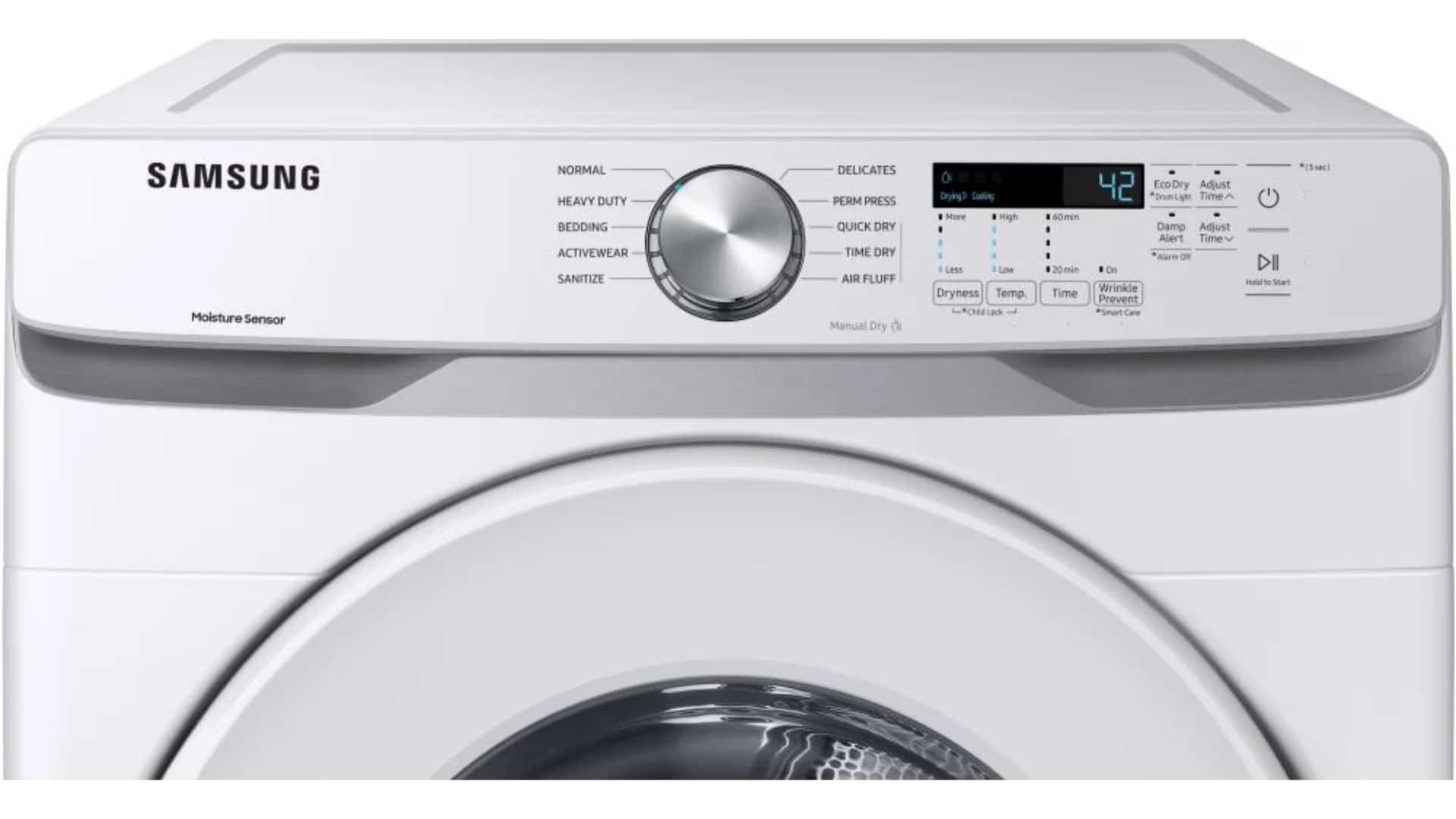Is your Samsung dryer not heating up as it should? You’re not alone.
Many Samsung dryer users face this frustrating issue, leaving them with damp clothes and a mountain of laundry. But don’t worry; we’re here to help you find a solution. Imagine the relief of drying your clothes efficiently again, without the stress of malfunctioning appliances.
By understanding the common causes and easy fixes, you’ll be back to enjoying fresh, dry laundry in no time. Dive into this guide to discover how you can troubleshoot and resolve your Samsung dryer heating issues, saving you time and unnecessary repair costs.

Credit: excellenceappliancerepair.com
Common Causes Of No Heat
Is your Samsung dryer leaving your clothes damp and cold? If so, you’re not alone. Many people face the frustrating issue of their dryer not heating properly. Understanding the common causes can help you troubleshoot and fix the problem quickly. Let’s dive into the key areas that might be causing your dryer to lose its heat.
Power Supply Issues
First things first, check the power supply. A dryer needs a consistent flow of electricity to function effectively. If your dryer isn’t heating, it might not be getting enough power. Verify that the plug is secure in the outlet and inspect the circuit breaker for any tripped switches. You’d be surprised how often this simple check solves the problem!
Faulty Heating Element
The heating element is like the heart of your dryer when it comes to generating heat. If it’s faulty, your dryer won’t heat up. You can test the heating element using a multimeter to see if it’s functioning correctly. Replacing a broken heating element might seem daunting, but it’s a straightforward fix if you’re comfortable with DIY tasks. Have you ever tackled a home repair project that seemed tricky but saved you money in the end?
Malfunctioning Thermal Fuse
A thermal fuse acts as a safety device that protects your dryer from overheating. If it blows, it cuts off the heat supply entirely. You can test the thermal fuse with a multimeter to confirm if it’s the culprit. A blown fuse is a common issue, and replacing it is often an easy task. Have you considered the importance of routine maintenance in avoiding such issues?
Defective Thermostat
The thermostat regulates your dryer’s temperature. If it’s defective, your dryer might not heat correctly. Testing the thermostat is essential to determine if it’s working as it should. Replacing a faulty thermostat can restore proper heat regulation. Imagine how frustrating it is when a small component disrupts your entire laundry routine!
So, what steps will you take to troubleshoot your dryer’s heating issue? Will it be a power check or a deep dive into components? Taking action not only saves you money but also extends the life of your dryer.

Credit: www.youtube.com
Initial Checks
Having trouble with your Samsung dryer not heating? Let’s tackle the problem with some initial checks. Before you rush to call a technician, there are a few things you can do yourself. These straightforward steps might just save you time and money. Who knows, you might be able to fix the issue in a matter of minutes! Let’s dive right into the first steps you should take.
Verify Power Connection
First things first, check if your dryer is properly plugged into the power outlet. It’s easy to overlook this simple step, especially if you have kids or pets that can accidentally unplug appliances. Make sure the plug is firmly inserted into the socket. Sometimes, the plug might appear to be in, but it’s not making full contact. Feel free to wiggle it a bit to ensure a snug fit.
Inspect Circuit Breaker
Next, head over to your circuit breaker panel. A tripped breaker could be the culprit behind your dryer not heating. If the breaker switch is in the off position, flip it back on. You might wonder why this happens, but high energy use can sometimes overload circuits, causing them to trip. If this fixes the issue, you’ve just saved yourself a service call!
Examine Dryer Settings
Are you sure you’re using the right settings on your dryer? Double-check the heat settings on your dryer. It’s possible you accidentally set the dryer to a non-heating mode, like air fluff or delicate. Switch to a higher heat setting and see if the dryer starts heating. Maybe you were in a rush or someone else changed the settings without realizing it. It’s a quick check that could solve your problem immediately.
These initial checks are simple, yet crucial. Have you experienced the joy of fixing an appliance on your own? Give these checks a try, and you might just experience that satisfaction. If your dryer still isn’t heating after these steps, there might be deeper issues at play. But at least you’ve ruled out the basics!
Testing Components
When your Samsung dryer stops heating, it can feel like a massive inconvenience. But before you start worrying about costly repairs or replacements, consider testing some components yourself. This process can be surprisingly simple and may save you both time and money. By focusing on specific parts such as the heating element, thermal fuse, and thermostat, you can often pinpoint the problem and take action.
Assessing Heating Element
The heating element is a crucial part of your dryer, responsible for generating the heat necessary to dry your clothes. If you suspect it’s faulty, testing it is straightforward. Unplug your dryer and locate the heating element, usually found behind the drum or at the bottom of the dryer.
Use a multimeter to check the continuity of the heating element. Set the multimeter to the lowest ohm setting and touch the probes to the terminals of the element. If the reading is infinite or shows no continuity, the element is likely broken and needs replacing.
Have you ever wondered why dryers fail so often? Sometimes, it’s due to lint build-up around the heating element, which can cause it to overheat and break. Regular cleaning can prevent this issue.
Checking Thermal Fuse
The thermal fuse acts as a safety measure, cutting off power to the heating element if the dryer overheats. If your dryer isn’t heating, this fuse might be blown. To test it, locate the thermal fuse, typically attached to the dryer’s exhaust duct.
Remove the fuse and use a multimeter to test for continuity. A reading of zero or close to it indicates the fuse is intact. However, if the multimeter shows infinite resistance, you’ll need to replace the fuse.
Why does the thermal fuse blow so easily? Often, it’s due to restricted airflow from clogged vents. Make it a habit to clean your dryer vents regularly to avoid this problem.
Evaluating Thermostat
The thermostat regulates the dryer’s temperature, ensuring your clothes dry at the right heat level. If your dryer runs but doesn’t heat, the thermostat may be malfunctioning. To test it, first identify the thermostat’s location, usually near the heating element.
Remove the thermostat and check its continuity with a multimeter. Set it to the lowest ohm setting and touch the probes to the thermostat’s terminals. A lack of continuity indicates a faulty thermostat that needs replacement.
Can you imagine drying clothes without temperature regulation? A failed thermostat can leave your clothes damp or even damage them due to overheating. Regular checks can prevent these issues.
By testing these components, you empower yourself with knowledge that can save you from unnecessary repair costs. So, next time your dryer acts up, roll up your sleeves and dive into these simple checks. Have you tried any of these tests before? What was your experience?

Credit: academy.fredsappliance.com
Replacing Faulty Parts
Is your Samsung dryer not heating up? It might be due to faulty parts. Replacing these parts can restore your dryer to optimal performance. This guide will help you identify and replace critical components. Discover how to replace the heating element, install a new thermal fuse, and change the thermostat. Each step is crucial for ensuring your dryer works efficiently.
Replacing Heating Element
The heating element generates heat for the dryer. If it’s faulty, your dryer won’t warm up. First, unplug your dryer for safety. Locate the heating element at the rear of the drum. You may need to remove some screws to access it. Once you find it, detach the wires connected to the element. Install the new heating element by connecting the wires securely. Ensure everything is tightly fastened. Test your dryer to confirm the heating issue is resolved.
Installing New Thermal Fuse
The thermal fuse prevents overheating. A blown fuse can stop heating. Unplug the dryer before starting. Find the thermal fuse near the blower housing. Use a multimeter to check if the fuse is blown. If it is, replace it with a new one. Simply remove the old fuse and insert the new one. Secure it properly to avoid any future issues. Test your dryer to see if the heat is back.
Changing Thermostat
The thermostat controls the temperature inside the dryer. A malfunctioning thermostat can cause heating problems. Disconnect the dryer from the power source. Locate the thermostat typically near the heating element. Remove the wires and screws holding it in place. Replace it with a new thermostat. Reconnect the wires and screws securely. Ensure everything is in place. Run your dryer to verify the fix.
Maintenance Tips
Regular maintenance keeps your Samsung dryer working efficiently. It also extends its lifespan. Simple tasks can prevent heating issues. Follow these tips for a well-functioning dryer.
Cleaning Lint Filter
Clean the lint filter after each drying cycle. This prevents clogs. A clogged filter can stop the dryer from heating properly. Pull out the filter and remove lint by hand. Use a brush for stubborn lint. A clean filter improves airflow and efficiency.
Regular Vent Inspection
Inspect the dryer vent regularly. Blocked vents cause heating problems. Disconnect the vent and check for lint buildup. Use a vacuum to clear any obstructions. Ensure the vent is properly connected when done. This ensures optimal airflow.
Scheduling Professional Maintenance
Schedule professional maintenance annually. A technician can spot hidden issues. They can clean parts you can’t reach. Regular checks prevent costly repairs later. It keeps your dryer in top condition.
When To Call A Professional
A Samsung dryer not heating can signal issues like a faulty thermostat or heating element. Call a professional if basic troubleshooting fails. Expert help ensures safety and correct repairs, avoiding further damage.
When your Samsung dryer stops heating, it can be tempting to dive right in and attempt a DIY fix. However, there are times when calling a professional is the smartest choice. Understanding when to make that call can save you time, money, and a lot of headaches.Complex Electrical Issues
Dryers involve intricate electrical systems that can be challenging to handle without experience. If your dryer’s heating element, thermostat, or internal wiring seems faulty, it might be time to contact a professional. They have the tools and expertise to safely and effectively diagnose and fix the issue. Attempting to fix these complex electrical problems on your own can lead to further damage or even pose a fire hazard. You wouldn’t want to accidentally turn a small issue into a costly disaster. Trusting an expert ensures that the repair is done correctly and efficiently.Persistent Problems
Has your dryer been heating inconsistently or stopped heating altogether despite your troubleshooting attempts? If you’ve tried the basics like cleaning lint filters or checking the power supply and the problem persists, it’s time to call in the pros. You may have overlooked something a professional can identify quickly. Think of it like having a persistent headache—sometimes, you need a doctor to find the root cause rather than just treating the symptoms. Let an expert diagnose persistent issues to restore your dryer’s functionality.Safety Concerns
Safety should always be your top priority. If you notice burning smells, sparks, or any signs of overheating, stop using the dryer immediately and call a professional. These signs indicate serious issues that could lead to fires or other hazards. Handling such situations without proper knowledge is risky. Would you risk your safety and that of your loved ones to save a few bucks? Sometimes, professional intervention is the safest and most responsible option. In your experience, have you ever tried fixing a home appliance only to realize it was more complicated than expected? Remember, knowing when to call a professional for your Samsung dryer not heating is not just about fixing the appliance—it’s about ensuring safety and peace of mind.Frequently Asked Questions
Why Is My Samsung Dryer Not Heating?
A faulty heating element could be the reason. Check the element and replace it if necessary.
How Do I Reset My Samsung Dryer?
To reset, unplug the dryer for 5 minutes. Plug it back in and start a new cycle.
Could A Clogged Vent Cause Heating Issues?
Yes, a clogged vent restricts airflow. Clean the vent to improve dryer performance.
Do Broken Thermostats Affect Dryer Heating?
Yes, they regulate temperature. Replace broken thermostats to restore proper heating.
Can Power Issues Lead To Heating Problems?
Absolutely. Check if the dryer is plugged in correctly and the circuit breaker is not tripped.
Conclusion
A Samsung dryer not heating can be frustrating. Simple checks often solve the issue. Ensure power is flowing properly. Clean lint filters regularly for better performance. Check the thermostat and heating element for faults. Sometimes, professional help is needed for complex problems.
Regular maintenance can prevent future heating issues. Keep the dryer well-ventilated for efficiency. Stay safe by unplugging before repairs. With these tips, you can tackle dryer problems confidently. Remember, proper care extends your dryer’s lifespan. Enjoy smoother laundry days ahead.




